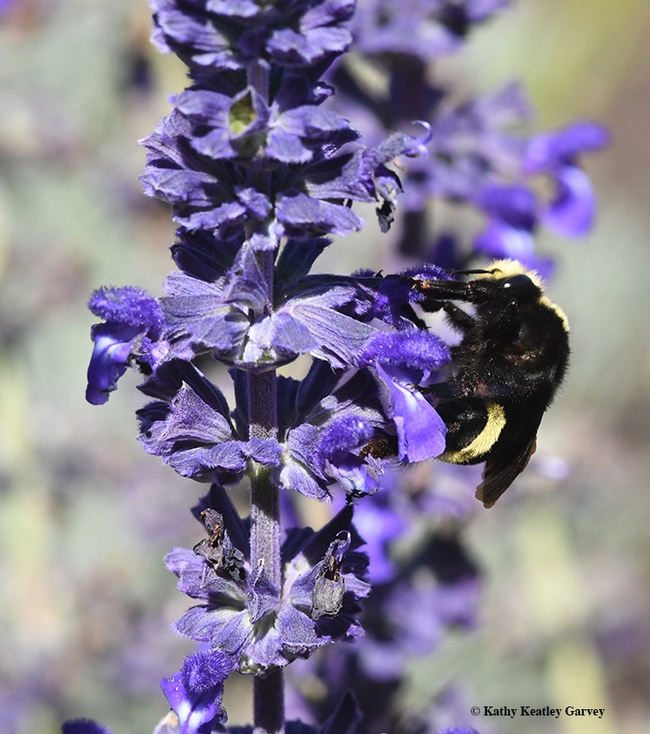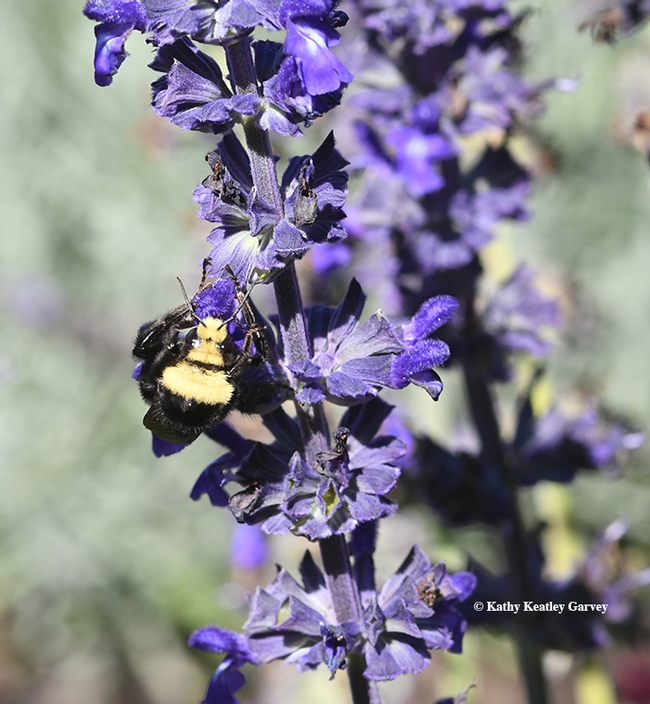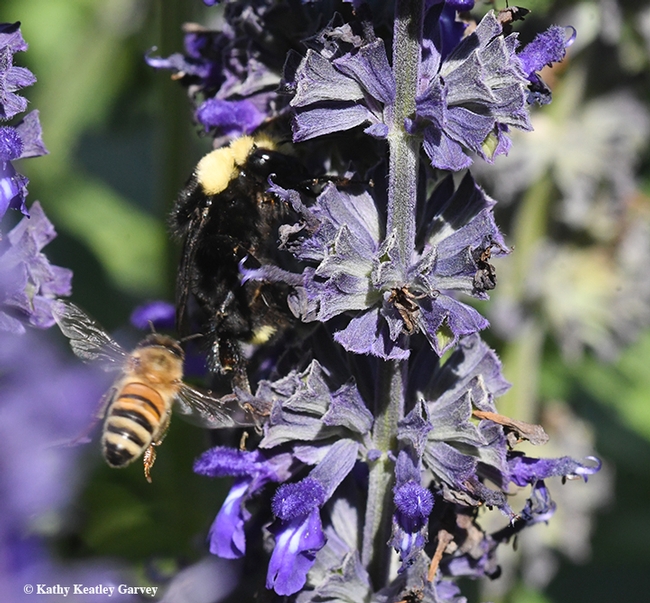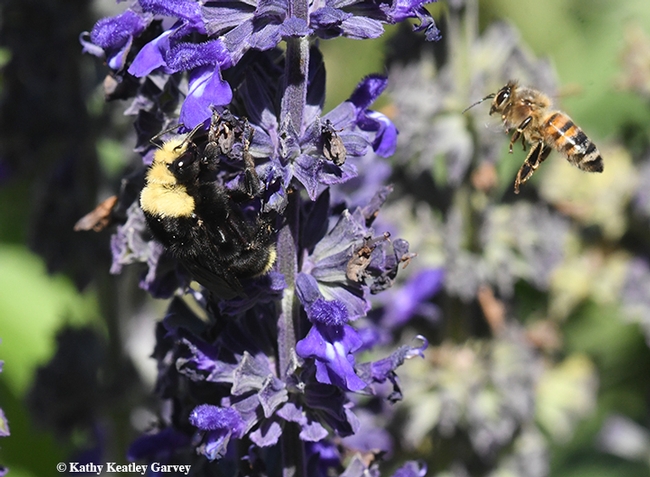- Author: Kathy Keatley Garvey
Bring on the bumble bees!
In yesterday's Bug Squad blog, we mentioned the unusual first-of-the-year bumble bee sightings at the Benicia Capitol State Historic Park. We captured images of the yellow-faced bumble bees, Bombus vosnesenskii, nectaring on jade, Crassula ovata, the morning of Jan. 1, 2018. They were packing cream-colored pollen.
Bombus vosnesenskii were also out and about at the Benicia Marina--same morning, same day--but on a different floral species: rosemary, Rosmarinus officinalis. This flower, too, yields a cream-colored pollen.
But wait! The bumble bees we saw foraging on the rosemary were packing orange pollen, as bright as Halloween pumpkins.
What happened? They didn't get it from the rosemary. It came from another plant, perhaps the early blooming California golden poppies which yield orange pollen (and no nectar).
Rosemary, which blooms nearly year-around in this area, belongs to the mint family, Lamiaceae, which also includes peppermint, spearmint, basil, lavender, marjoram, germander, thyme, savory, and horehound. One of the distinguishing features in this family: square stems.
When you think about it, rosemary's presence at the marina is quite appropriate. It derives its name from the Latin "dew" (ros) and "sea" (marinus), or "dew of the sea."
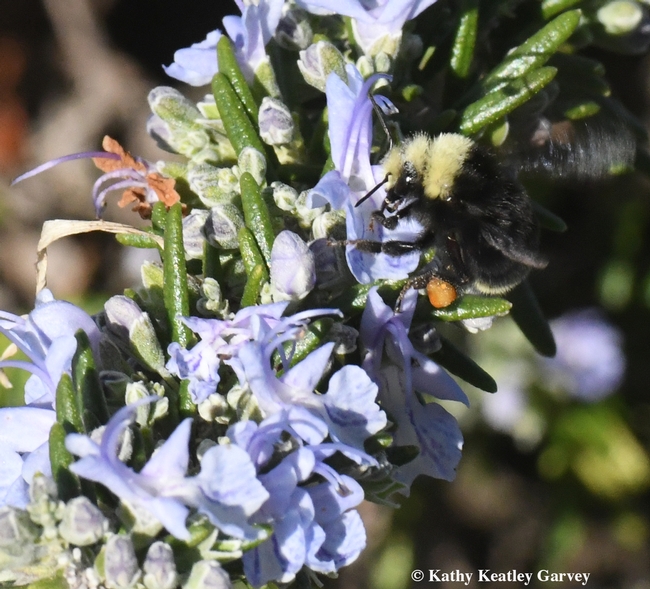
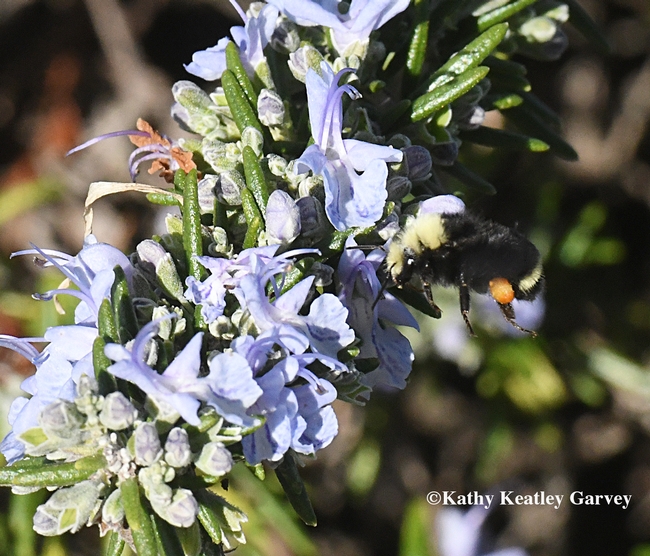
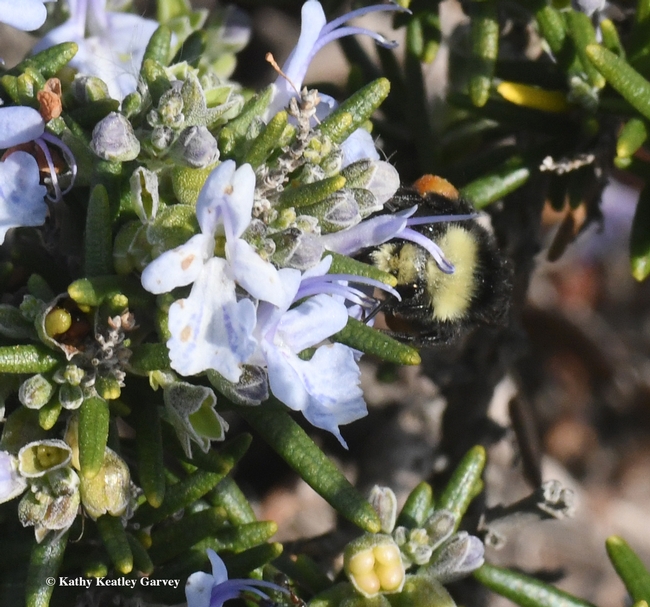
- Author: Kathy Keatley Garvey
While folks from Alaska to Colorado to New York to Maine are shivering in freezing temperatures, here in sunny California--well, at least parts of the Golden State are sunny--bumble bees are foraging on winter blooms.
Bumble bees? On the first day of the year?
Yes. We spotted a dozen yellow-faced bumble bees, Bombus vosnesenskii, nectaring this morning in Benicia, Solano County, Calif.
They were foraging on jade at the Benicia Capitol State Historic Park and on rosemary at the Benicia Marina. Honey bees and syrphid flies joined them. We also saw some hungry predators--birds--chasing them.
For the last several years, several of us bumble bee aficionados--led by Robbin Thorp, distinguished emeritus professor of entomology at the University of California, Davis--seek to find and photograph the first bumble bee of the year.
Last year the big winner was naturalist and insect photographer Allan Jones of Davis. At 2:02 p.m., on Friday, Jan. 27, he alerted us: "Two Bombus melanopygus on manzanita just east of the redwood grove (UC Davis Arboretum)."
And then he found another melanopygus. It was a three-in-one day.
The story behind the story: Inspired by Robbin Thorp, a small group of eager bumble bee aficionados--naturalists and insect photographers Gary Zamzow and Allan Jones of Davis, and yours truly of UC Davis--launched the First-Bumble-Bee-of-the-Year Contest six years ago.
It's a take-off of Art Shapiro's "Beer for a Butterfly" contest. Shapiro, a distinguished professor of evolution and ecology at UC Davis, offers a pitcher of beer for the first cabbage white butterfly (Pierae rapae) of the year found in the three-county area of Sacramento, Yolo and Sacramento. He launched the contest in 1972 as part of his long-term studies of butterfly life cycles and climate.
For us bumble bee aficionados, the prize isn't a pitcher of beer. There's no prize. It's basically to provide a few more eyes to help Robbin Thorp track early-season bumble bees.
Thorp is the co-author of Bumble Bees of North America: An Identification Guide (Princeton University Press) and California Bees and Blooms: A Guide for Gardeners and Naturalists (Heyday).
Meanwhile, look around for bumble bees in your area. You won't find them in the "deep freeze" states like Alaska, North Dakota or Minnesota. And you certainly won't find them in Hettinger, N.D., where the temperature dipped to a negative 45 degrees today.
But if you're in Benicia or another sunny place, it's a Bumble Bee Kind of Day and what a way to begin the New Year!
Happy New Year!
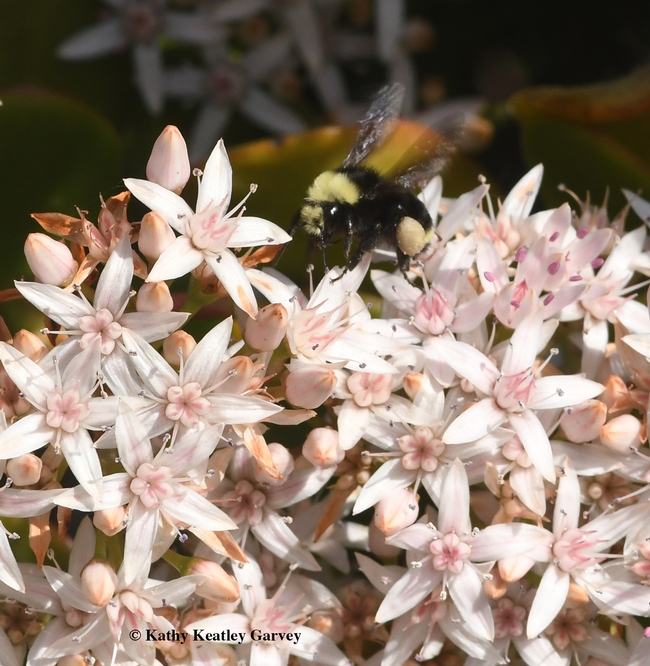
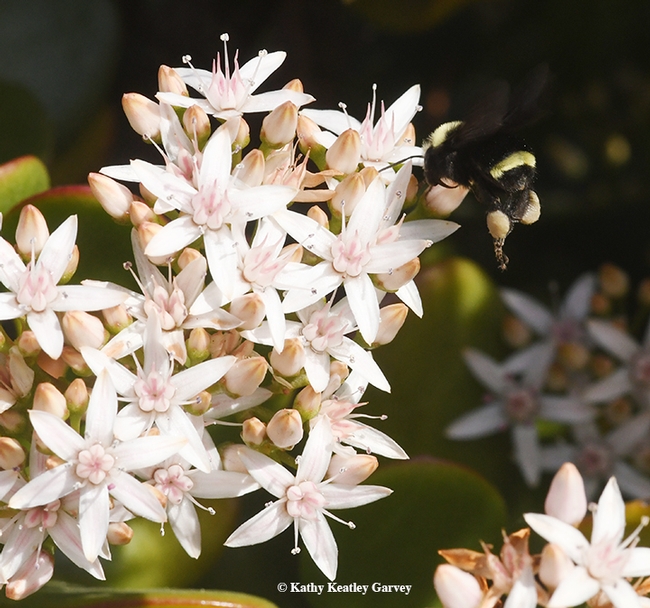
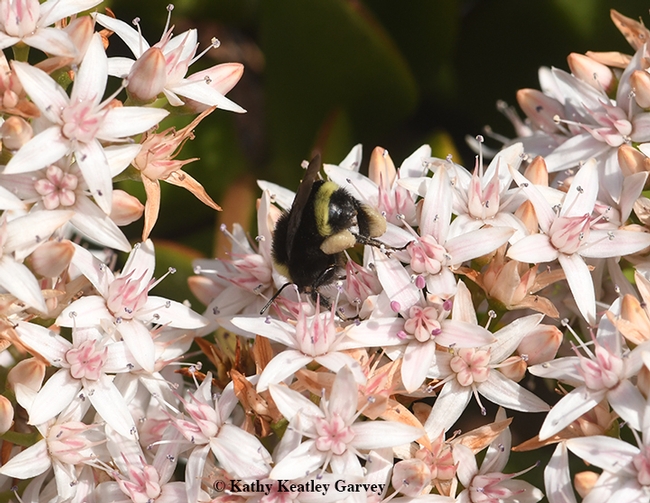
- Author: Kathy Keatley Garvey
You never know what you'll find when you visit a pollinator garden.
Take the case of our visit Nov. 12 to the Sonoma Cornerstone, Sonoma, to see the pollinator garden of Kate Frey, an ardent pollinator advocate, world-class garden designer, and co-author of The Bee Friendly Garden with UC San Francisco professor Gretchen LeBuhn.
The flower-filled Frey garden is a people/pollinator favorite at the Sonoma Cornerstone, and no wonder.
We spotted a yellow-faced queen bumble bee, Bombus vosnesenskii, foraging on Salvia Indigo spires. Normally, you don't see bumble bees this time of year, but this one came out of hibernation temporarily to eat. She appeared famished!
Bombus vosnesenskii is among the bees featured in the University of California-authored book, California Bees and Blooms: A Guide for Gardeners and Naturalists (Heyday Press). It's the work of entomologists Gordon Frankie of UC Berkeley and Robbin Thorp of UC Davis, entomologist/photographer Rollin Coville and plant expert Barbara Ertter of UC Berkeley. Thorp, a UC Davis distinguished emeritus professor, also co-authored Bumble Bees of North America: An Identification Guide (Princeton University).
In their book, California Bees and Blooms, the authors call attention to this iconic Bombus species: the yellow hairs on the face and top of head, and the yellow stripe on the abdomen.
Hibernating queen bumble bees are a joy to photograph as they forage for food, buzzing from blossom to blossom to sip nectar. This one seemed to be braking during a winter break.
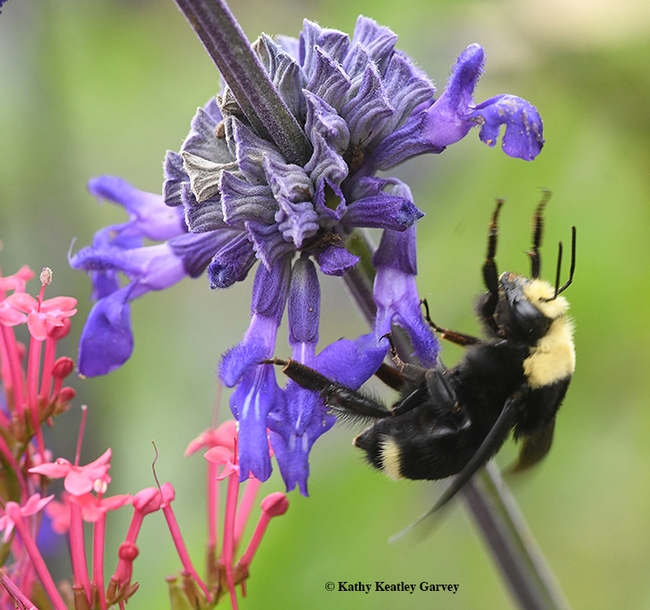
- Author: Kathy Keatley Garvey
It's Thanksgiving Day and time to give thanks for NOT what we WANT, but what we HAVE.
And, not for what we OWN, but what we CANNOT.
That includes the yellow-faced bumble bee, Bombus vosnesenskii.
On the morning of Nov. 12, we traveled to the Sonoma Cornerstone, Sonoma, to check the plants and pollinators in Kate Frey's amazing pollinator garden. Kate Frey, co-author of The Bee-Friendly Garden" (with UC San Francisco professor Gretchen LeBuhn), is a world-class garden designer and pollinator advocate.
Flashback to Sept. 23, the last time we visited the Frey garden. We noticed monarch butterflies, painted ladies, honey bees and--one bumble bee, a hungry queen Bombus vosnesenskii, newly emerged from winter hibernation to grab something to eat. Sometimes on warm sunny days, the queens will disrupt their hibernation to search for nectar. They. Are. Hungry.
At 12:30 on Nov. 12, the temperature rose to 62 degrees.
And then we saw her, The Queen. The Queen. Resplendent in gold and black, she buzzed loudly toward the spiked floral purple plant, Salvia indigo spires (Salvia farinacea x S. farinacea). Honey bees quickly moved out of her way as she claimed the nectar, all of it. Her wings glowed in the sunlight and her buzz seemed loud enough to break the sound barrier.
Is there anything more bee-utiful?
One bumble bee. One queen. A royal moment.
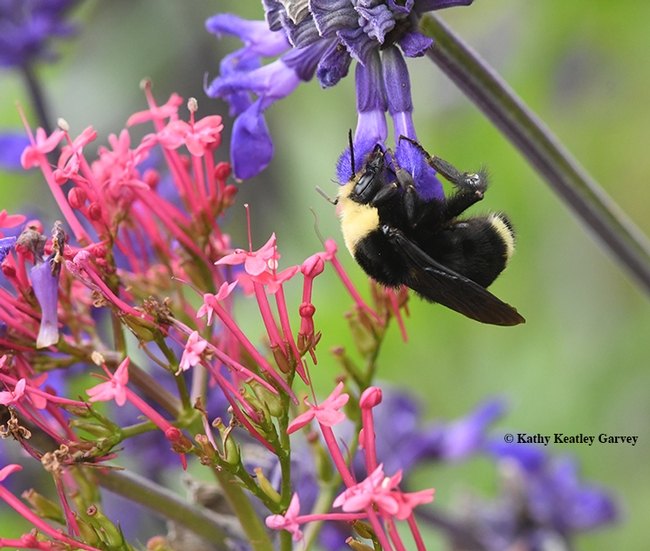
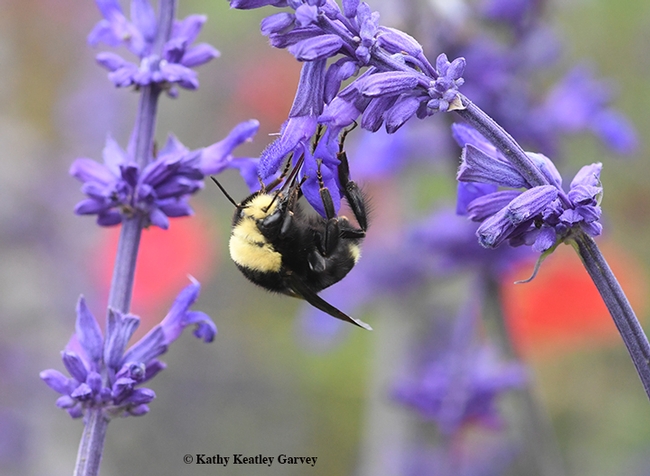
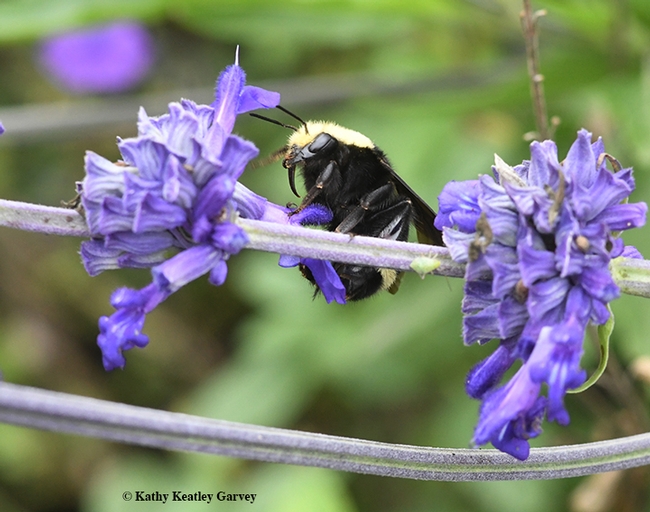
- Author: Kathy Keatley Garvey
The news is disturbing but not unexpected.
Scientists are linking global climate change to one reason why the worldwide population of bumble bees is declining.
An article published Sept. 28 in the journal Ecology Letters by Florida State University (FSU) researchers showed that bumble bees just aren't getting enough floral resources.
For the study, lead researcher and postdoctoral fellow Jane Ogilivie and six colleagues examined three subalpine bumble bee species in Colorado's Rocky Mountains, and found that the changing climate means fewer flowers.
"Knowing whether climate variation most affects bumble bees directly or indirectly will allow us to better predict how bumble bee populations will cope with continued climate change," Ogilivie told the FSU News Service in a press release. "We found that the abundances of all three bumble bee species were mostly affected by indirect effects of climate on flower distribution through a season."
The FSU News Service aptly headlined the research a "Stinging Report."
"When researchers think about flower effects on bees, they typically consider floral abundance to be the most important factor, but we found that the distribution of flowers throughout a season was most important for bumble bees,” Ogilivie said. “The more days with good flower availability, the more bees can forage and colonies can grow, and the bigger their populations become. We now have longer flowering seasons because of earlier snowmelt, but floral abundance has not changed overall. This means we have more days in a season with poor flower availability.”
The researchers wrote in their abstract: "Climate change can influence consumer populations both directly, by affecting survival and reproduction, and indirectly, by altering resources. However, little is known about the relative importance of direct and indirect effects, particularly for species important to ecosystem functioning, like pollinators. We used structural equation modelling to test the importance of direct and indirect (via floral resources) climate effects on the interannual abundance of three subalpine bumble bee species. In addition, we used long-term data to examine how climate and floral resources have changed over time. Over 8 years, bee abundances were driven primarily by the indirect effects of climate on the temporal distribution of floral resources. Over 43 years, aspects of floral phenology changed in ways that indicate species-specific effects on bees. Our study suggests that climate-driven alterations in floral resource phenology can play a critical role in governing bee population responses to global change."
Bumble bee expert Robbin Thorp, distinguished emeritus professor of entomology at the University of California, Davis, long ago sounded the alarm that bumble bees are in trouble. He is the co-author of Bumble Bees of North America: an Identification Guide (Princeton) and California Bees and Blooms: A Guide for Gardeners and Naturalists.
The last bumble bee we saw--the last of the season--was on Sept. 23 at Kate Frey's pollinator garden at the Sonoma Cornerstone, Sonoma. It was a yellow-faced queen bumble bee, Bombus vosnesenskii, nectaring on a spiked floral purple plant, Salvia ‘Indigo Spires' (Salvia farinacea x S. farinacea). The queen had apparently emerged from hibernation to find food on that warm summerlike day.
I knelt to capture some images.
"Oh, it's just a bumble bee," scoffed one tourist, casually sipping a glass of wine. "They're everywhere."
Sadly, they're not.
